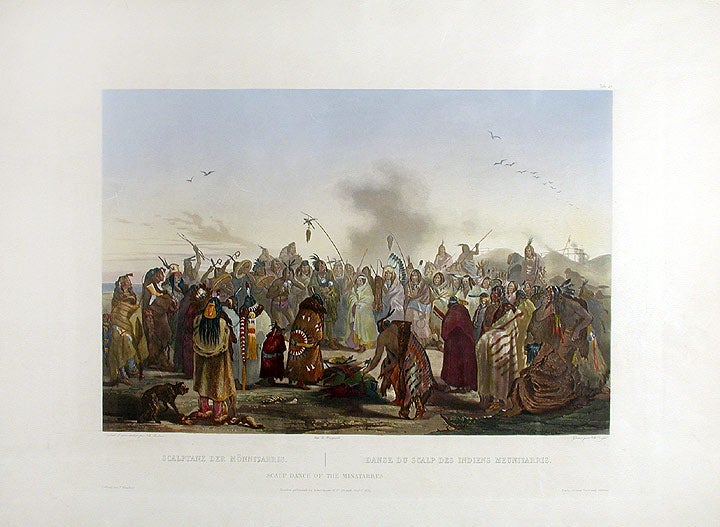BODMER, Karl (1809-1893)
Scalp Dance of the Minatarres
[Tab. 27] [Leipzig: Schmidt and Guenther, 1922]. Hand-coloured aquatint engraving by Ch. Vogel after Bodmer. Small marginal tears not affecting plate area. Sheet size: 18 13/16 x 25 1/2 inches. Plate mark: 16 x 21 inches.
From the scarce Leipzig edition printed from the original copper-plates. Limited in number, the prints from the Leipzig edition are more scarce than, and compare favorably to, the first edition. (David C. Hunt, "Karl Bodmer and the American Frontier," Imprint/Spring 85, p.18)
An important record of this energetic victory dance, executed by Bodmer during the winter of 1833-1834 when the travelers stayed at Fort Clark on the banks of the upper reaches of Missouri River. The Hidatsa's came to the fort twice to perform their scalp dance, once in February 1834 after a retaliatory raid against the Assiniboins, and again in April after a surprise attack on a Sioux camp. The figure shown center right is Máhchsi-Níhka (`Young War Eagle'), a deaf-mute who had played a prominent part in the raid against the Assiniboins. To the far left is Síh-Sä (`Red Feather'), a Mandan man who had been raised by the factor of Fort Clark, although he still has relatives in the village. The women play a principal role in the dance and have donned military attire, painted their faces like warriors, carried weapons and displayed scalp trophies. Musical accompaniment is provided by the men with the drums and rattles. Karl Bodmer's images show great versatility and technical virtuosity and give us a uniquely accomplished and detailed picture of a previously little understood (and soon to vanish) way of life. Swiss-born Bodmer was engaged by Prince Maximilian zu Wied-Neuwied (1782-1867) specifically to provide a record of his travels in North America, principally among the Plains Indians. In the company of David Dreidoppel (Prince Maximilian's servant and hunting companion), their travels in North America were to last from 1832 to 1834. Well-armed with information and advice, the party finally left St.Louis, on the most important stage of their travels, aboard the steamer Yellow Stone on April 10 1833. They proceeded up the treacherous Missouri River along the line of forts established by the American Fur Company. At Bellevue they encountered their first Indians, then went on to make contact with the Sioux tribe, learning of and recording their little known ceremonial dances and powerful pride and dignity. Transferring from the Yellow Stone to another steamer, the Assiniboin, they continued to Fort Clark, visiting there the Mandan, Mintari and Crow tribes, then the Assiniboins at Fort Union, the main base of the American Fur Company. On a necessarily much smaller vessel they journeyed through the extraordinary geological scenery of that section of the Missouri to Fort Mackenzie in Montana, establishing a cautious friendship with the fearsome Blackfeet. From this, the westernmost point reached, it was considered too dangerous to continue and the return journey downstream began. The winter brought its own difficulties and discomforts, but Bodmer was still able to execute numerous studies of villages, dances and especially the people, who were often both intrigued and delighted by his work. The portraits are particularly notable for their capturing of individual personalities, as well as forming a primary account of what were to become virtually lost cultures.
David C. Hunt, "Karl Bodmer and the American Frontier," Imprint/Spring 1985, p.18. Cf.Graff 4648; cf. Howes M443a; cf. Pilling 2521; cf. Sabin 47014; cf. Wagner-Camp 76:1.
Item #15565
Price: $2,850.00


